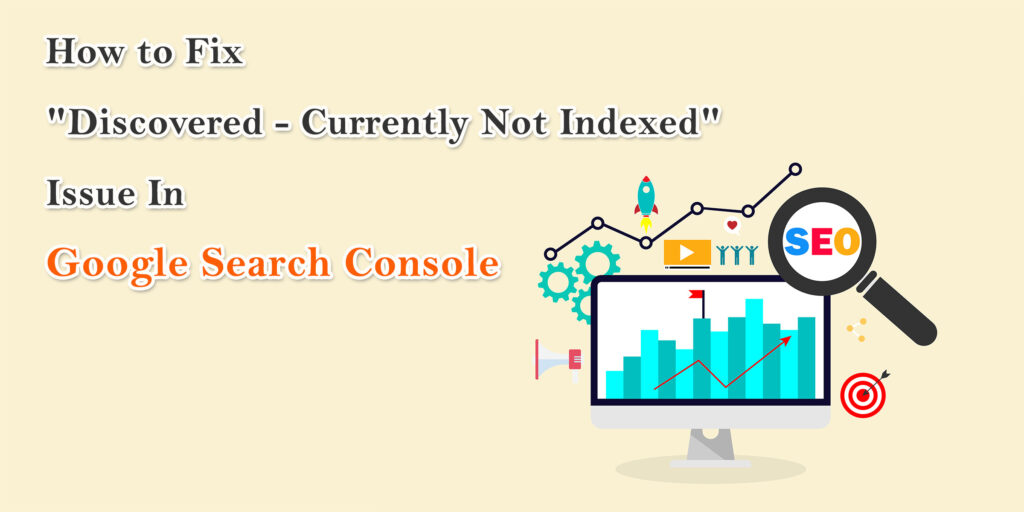In the ever-evolving world of SEO (Search Engine Optimization), website owners and digital marketers often come across a puzzling message from search engines: “Discovered – Currently Not Indexed.” This message can be a cause of concern, as it indicates that search engines have found your web pages but haven’t included them in their index. In this comprehensive guide, we will delve into the depths of this issue, exploring what “Discovered – Currently Not Indexed” means, what causes it, how to avoid it, and most importantly, how to fix the pages that are already facing this issue.
1. What is “Discovered – Currently Not Indexed”?
To understand the “Discovered – Currently Not Indexed” issue, let’s break down the message:
“Discovered”: This part of the message means that search engines, such as Google, have detected the existence of your web page during their crawling process. They’ve found your page while navigating through the web.
“Currently Not Indexed”: This portion of the message signifies that although the search engine has discovered your page, it has chosen not to include it in its index. In simpler terms, your page is not appearing in search engine results pages (SERPs) because it’s not part of the search engine’s database.
In essence, your web page has been found by search engine crawlers but hasn’t made it into the searchable index. This can be a problem because it means your content won’t appear in search results, severely impacting your website’s visibility and, consequently, its traffic.
2. What Causes This Issue?
Several factors can lead to the “Discovered – Currently Not Indexed” issue:
2.1 Low-Quality Content: One of the most common reasons for pages not getting indexed is low-quality or thin content. Search engines prioritize pages that provide value to users. If your content lacks substance, it may not make the cut.
2.2 Duplicate Content: Duplicate content across your website or from other sources can confuse search engines. They may choose not to index pages with duplicate content to prevent redundancy in their search results.
2.3 Crawling Issues: If search engine bots encounter technical difficulties while crawling your site, they may not index your pages. Common crawling issues include server errors, slow load times, and disallowing bots in the robots.txt file.
2.4 Canonicalization Issues: When canonical tags are misconfigured on your pages, search engines may have trouble determining which page to index, leading to the exclusion of some pages.
2.5 Low Authority or Trustworthiness: Search engines evaluate the authority and trustworthiness of websites. If your website lacks credibility or has a poor backlink profile, your pages may not get indexed.
2.6 Overuse of “Noindex” Tags: Webmasters can use “noindex” tags to prevent search engines from indexing specific pages. If you inadvertently apply these tags to important pages, they won’t appear in search results.
2.7 Excessive URL Parameters: If your website generates many URL variations with parameters, it can lead to duplicate content issues, causing search engines to skip indexing some pages.
3. Search Engine Index Budget for Each Website
Understanding the concept of a search engine’s “index budget” is crucial to comprehending why some pages might not get indexed. Search engines allocate a finite amount of resources, often referred to as an index budget, to crawl and index web pages. This index budget is not the same for all websites and can vary based on factors like the website’s authority, trustworthiness, and historical performance.
For established and authoritative websites, search engines may allocate a larger index budget, allowing them to crawl and index more pages more frequently. Conversely, newer or less authoritative websites might have a smaller index budget, restricting the number of pages that can be crawled and indexed.
This concept highlights the importance of optimizing your website’s content and structure to make the most of your index budget. Prioritizing high-quality, unique, and valuable content, while also ensuring technical aspects like site speed and crawlability are optimized, can help you make the most of your allocated index budget.
4. How to Avoid This Issue
Prevention is often the best cure when it comes to the “Discovered – Currently Not Indexed” issue. To avoid encountering this problem in the first place, follow these best practices:
4.1 Create High-Quality Content: Invest in creating valuable, informative, and unique content that serves the needs of your target audience. Content quality is a significant factor in search engine rankings and indexing.
4.2 Resolve Duplicate Content: Identify and address any duplicate content issues on your website. Use canonical tags to specify the preferred version of a page when necessary.
4.3 Ensure Proper Crawling: Regularly monitor your website for crawling issues, such as server errors, slow load times, and blocked resources. Use tools like Google Search Console to identify and fix crawl errors promptly.
4.4 Optimize Technical SEO: Pay attention to technical SEO aspects like URL structure, internal linking, and the use of header tags to improve the overall crawlability of your site.
4.5 Earn Trust and Authority: Build a strong online presence and earn trust by acquiring high-quality backlinks from reputable websites. Establishing authority in your niche can lead to better indexing rates.
4.6 Review “Noindex” Tags: Periodically audit your website for “noindex” tags and ensure they are correctly applied only to pages that should not be indexed.
4.7 Manage URL Parameters: If your site generates URL parameters, use tools like Google Search Console to specify which parameters should be ignored by search engines to prevent duplicate content issues.
By implementing these preventive measures, you can increase the chances of your web pages being crawled and indexed successfully.

5. How to Fix Pages Already Facing This Issue
If you’ve already encountered the “Discovered – Currently Not Indexed” issue on some of your web pages, don’t worry; there are steps you can take to rectify it:
5.1 Content Quality Improvement: Start by enhancing the quality of the content on the affected pages. Add more valuable information, improve readability, and ensure the content serves the user’s intent.
5.2 Canonicalization: Check if there are any canonicalization issues on these pages. Ensure that canonical tags are correctly set to avoid confusion for search engines.
5.3 Remove “Noindex” Tags: If you’ve mistakenly applied “noindex” tags to important pages, remove them to allow search engines to index those pages.
5.4 Technical SEO Audit: Conduct a comprehensive technical SEO audit to identify and address any crawling or indexing issues, such as server errors, slow load times, or blocked resources.
5.5 Fetch as Google: Use Google Search Console’s “Fetch as Google” tool to manually request indexing of specific pages. This can help expedite the indexing process for important content.
5.6 Update Sitemaps: Ensure that the pages you want to index are included in your website’s sitemap. Submit the updated sitemap to search engines for re-crawling.
5.7 Monitor Progress: After taking corrective actions, monitor your website’s performance in search results. It may take some time for search engines to re-crawl and re-index your pages, so be patient.
5.8 Build Authority: Work on building the authority of your website by acquiring high-quality backlinks and consistently creating valuable content. An authoritative website is more likely to get indexed.
Wrapping Up
The “Discovered – Currently Not Indexed” issue can be a source of frustration for website owners and digital marketers, as it hinders a website’s visibility in search engine results. Understanding the causes of this issue, the concept of search engine index budget, and implementing preventive measures can help you avoid encountering it in the first place.
If you do encounter the issue on some of your web pages, follow the steps outlined in this guide to rectify it. Remember that patience is key when waiting for search engines to re-crawl and re-index your pages. By adhering to SEO best practices and continuously optimizing your website, you can improve your chances of having your valuable content featured prominently in search results.
For more information, visit Bel Oak Marketing.





